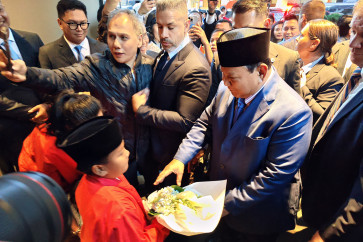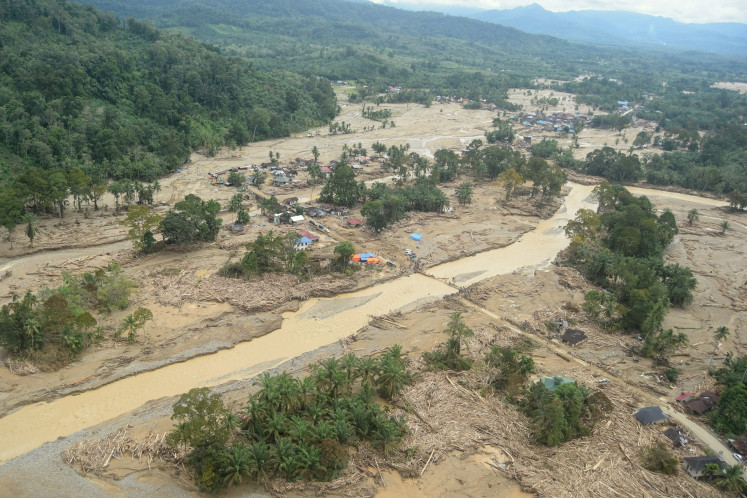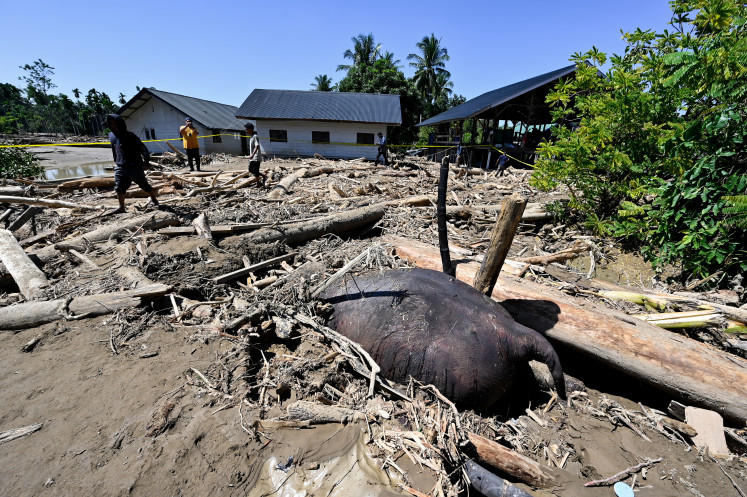Popular Reads
Top Results
Can't find what you're looking for?
View all search resultsPopular Reads
Top Results
Can't find what you're looking for?
View all search resultsTake your palate on safari
Last year (Aug
Change text size
Gift Premium Articles
to Anyone
L
ast year (Aug. 22-24, 2008), a great South African Wine festival was held in Jakarta, prominently featuring Cape Wine master Junel Vermeulen. This year, however, they organized just a wine tasting event featuring La Motte and Leopard's Leap wines, at the poolside of the Thamrin Executive Residence (on Oct. 19, 2009), the evening before the inauguration of the new President and Vice President of this country. South African Ambassador to Indonesia Dr. Noel N. Lehoko told me that every year there would be a South African wine event supported by his embassy in Jakarta.
Intriguingly, this time they did not feature their "national" wine, Pinotage. Instead, Leopard's Leap marketing and sales director Marius Kotz* highlighted La Motte and Leopard's Leap Shiraz, perhaps in an attempt to challenge Australian Shiraz, which is quite popular among Indonesian wine drinkers.
"Aussie Shiraz is sweet, with black berry flavors," Kotz* said. "Ours are spicy, with red berry flavors." However, I didn't taste any red berry flavors in the 2006 La Motte Platinum Collection Shiraz upon pouring, but could easily taste some black berry *blackcurrant, mulberry*, preserved Chinese plums, and raisins. The sweetness was there, although it was not as striking as in Australian Shiraz. Strangely, this rich, full-bodied Shiraz demonstrates intense spiciness of white pepper instead of the usual black pepper, and intense umami (savory) flavors.
However, about 40 minutes later, it went flat and tasted all tannins. And about one hour later, it mellowed and was transformed into a serious, well-balanced wine, reminiscent of Rhone Valley Syrah. The intense umami flavors were now gone and slight raspberry flavors appeared. This wine certainly needs proper decanting.
Perhaps this demonstrates what Marius told me earlier: "South African wines are a combination of Old World and New World wine. I mean, we use Old World techniques to produce New World style, which is more accessible, fruit-driven, and easily drinkable. Not many people like Old World style *wines* which are one dimensional, powerful, complex and not easier *on the palate*." He also told me that the Rupert family's affinity to Rhone Valley Syrah makes them model their Shiraz after Rhone's style.
Leopard's Leaf Special Edition Shiraz 2007 is a lighter, more accessible version of La Motte Shiraz. Unlike La Motte, which undergoes meticulous treatment (the grapes are handpicked and sorted from carefully selected blocks), 10 percent of the grapes used to produce Leopard's Leap come from family vineyards and the other 90 percent are from other producers in five different climatic areas throughout the country.
So, La Motte is an estate wine and Leopard's Leap is its commercial line. This is reflected in their prices. In the UK, the former retails at *12 and the latter at *7 per bottle and at Kemang Duty Free Jakarta at US$61 and $17.40 per bottle.
However, the best Shiraz I tasted that evening was 2006 La Motte Pierneef Collection Shiraz Viognier. It was approachable right from the start, even without decanting. There were no excessive umami flavors. Everything was nicely held in equilibrium. Obviously, the Viognier plays a crucial role in softening the Shiraz and contributing finesse.
Inspired by the Cote Rotie style in the northern Rhone area, this wine is a blend of 91 percent Shiraz and 9 percent Viognier. The Shiraz component is from Darling (50 percent), Stellenbosch (30 percent) and Swartland (20 percent), while the Viognier originates from a vineyard in the Franschhoek region.
The other Shiraz featured in the wine tasting was 2006 Leopard's Leap Family Collection Shiraz Mourv*dre Viognier. Made from 75 percent Shiraz, 20 percent Mourv*dre, 5 percent Viognier, this wine was spicy and more tannic than the other Shirazes. Red berry is there, its acidity was quite high (6.8 g/ l) and it was less savory than the Platinum Shiraz. Apparently, it begs for food.
Other than the Shirazes, there were other reds and a white, La Motte Pierneef Collection Sauvignon Blanc, which impressed many. Some even told me they liked it better than the reds.
La Motte is 100 percent owned by Hanneli Rupert and Leopard's Leap is equally owned by her and her husband, Hein Koegelenberg. Marius said the Rupert family who produces the wine also owns some of the world's prestigious luxury brands such as Cartier, Mont Blanc and Shanghai Tang, but "we are not allowed to mix the luxury side and the wine side".
The reason is obvious. South African wine is still widely known as reasonably-priced quality wine, not luxury wine. In Asia, it ranks fourth after French, Australian and Chilean wines in terms of sales by volume, according to business development director for Asia James N. Tan.
So, it makes sense not to associate the luxury with the not-so-luxury. However, they actively associate Leopard's Leap with the leopard in their US$10 million Corporate Social Responsibility project. "The more *Leopard's Leap* you drink, the more you can save the Cape Mountain leopard ." appealed Lehoko in his speech in which he mentioned that Kenya and Zimbabwe have also begun to make wines. But that's another story.










